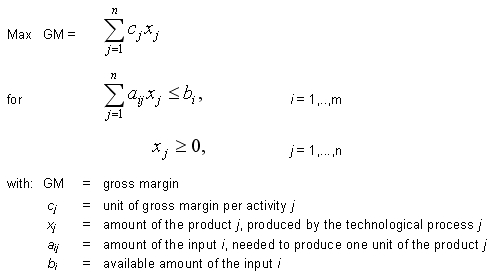The MODAM LP-Approach
In agricultural economics linear programming models are a widely accepted planning tool to support solving complex decision finding problems. To do so a linear inequation system is formulated that describes agricultural activities as elements limited in their extent by predefined restrictions. The inequation system is solved for a set goal function using a programmed solver like the Microsoft ExcelTM build in solver or another solver available on the software market. The formulation of the optimisation problem can be described as follows (Paris 1991):

The optimisation process in MODAM beyond the usual restrictions like 'available amount of labour in a period' or 'needs of a cow regarding feed ingredients' also takes into account environmental quality targets in form of further restrictions. In the inequation system the pressure of agricultural landuse on the environment is regarded as the consumption of environmental goods. For any production activity the corresponding consumption of the environmental good kj is recorded. The total use of the commodity 'environment' k for a number of products j is further on regarded as a restriction. The balancing of this restriction can be used to calculate trade-off functions which simulate the costs for a rising demand in the corresponding environmental good. The consumption of environmental goods can be described as additional restriction (Schuler & Kächele 2003):

The MODAM linear programming approach is based on two elements, the LP-generator and the LP-solver. The LP-Generator in MODAM is realised by a database that automatically generates a matrix structure for as much farms, fields and production practices as were defined in the corresponding project in the set editor. The farm model simulates significant relationships between different production units of the farm and its resources. Individual sites are modelled with all coresponding restrictions. The matrix is generated in such a way that several farms can be optimised simultaneously. This allows the application of the modelling system for various applications:
- single farm models
- regional farms
- regional models of multiple farm types
For more detailed information on matrix structure see Kächele (1999) and Zander et al. (1999).
Literature
Kächele, H. 1999. Auswirkungen großflächiger Naturschutzprojekte auf die Landwirtschaft. Ökonomische Bewertung der einzelbetrieblichen Konsequenzen am Beispiel des Nationalparks "Unteres Odertal". Agrarwirtschaft. (Sonderheft 163): 222p
Paris, Qu. 1991. An economoic interpretation of linear programming. Ames: Iowa State university Press. 337 p.
Schuler, J. and H. Kächele 2003. Modelling on farm cost of soil conservation policies with MODAM. Environmental Science and Policy. 6(1): p. 51-55.
Zander, P., H. Kächele and A. Meyer-Aurich. 1999. Development and application of a multiobjective decision support tool for agroecosystem management (MODAM). Quarterly Bulletin of the International Association of Agricultural Information Specialists. 44(1/2): p. 66-72.

